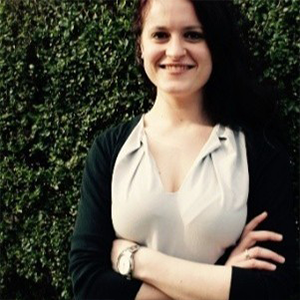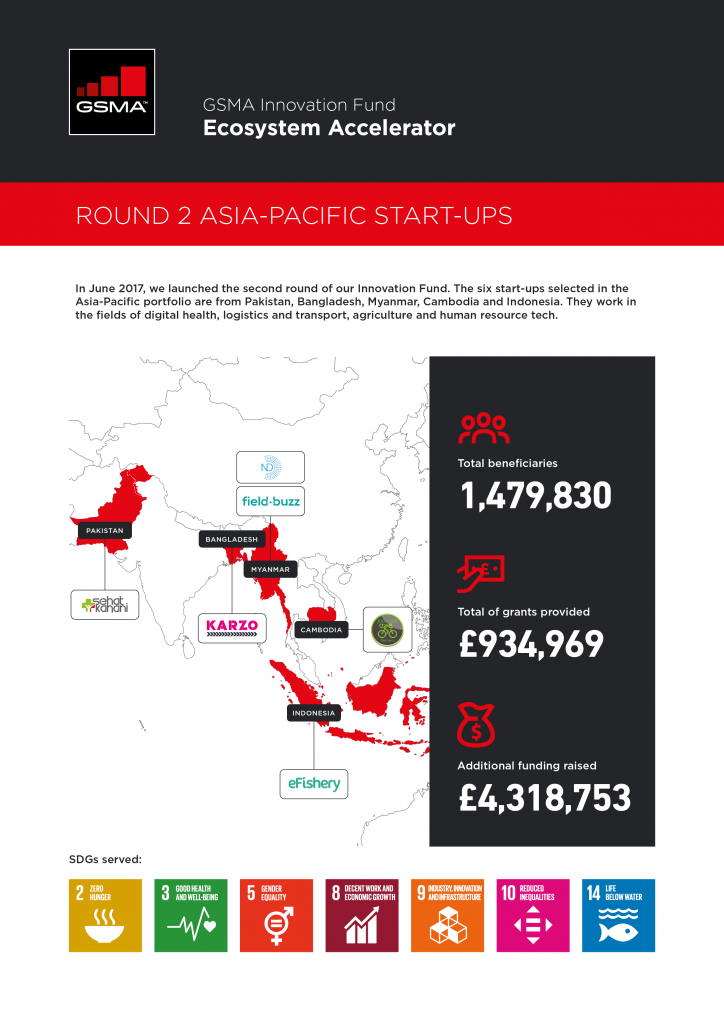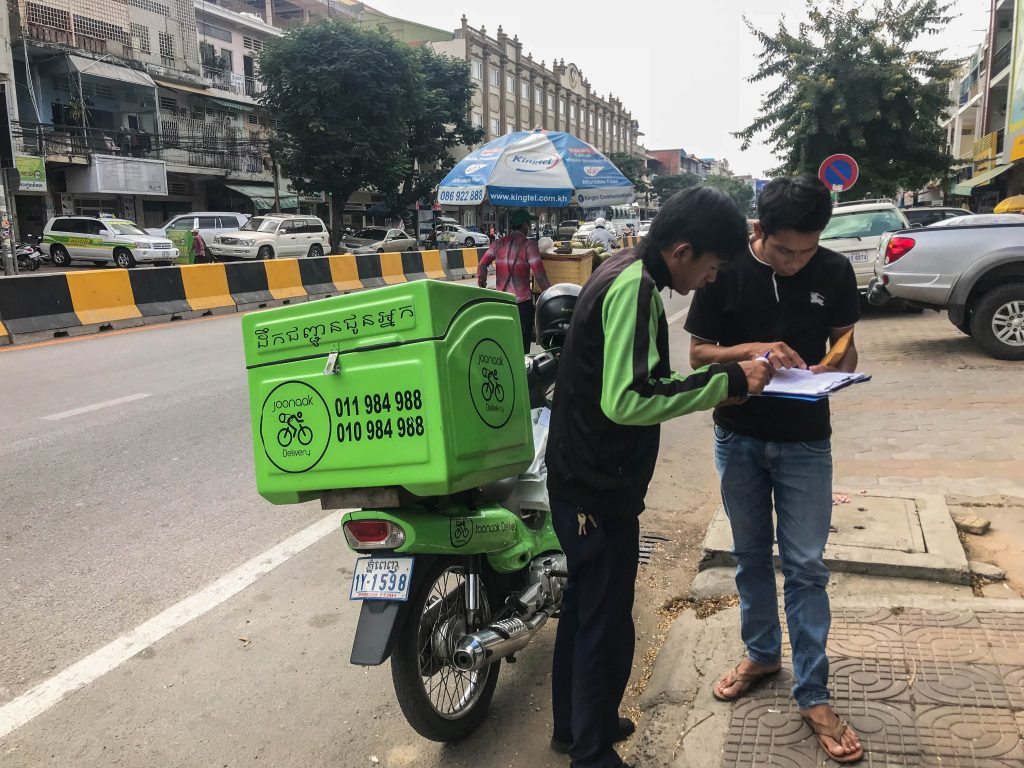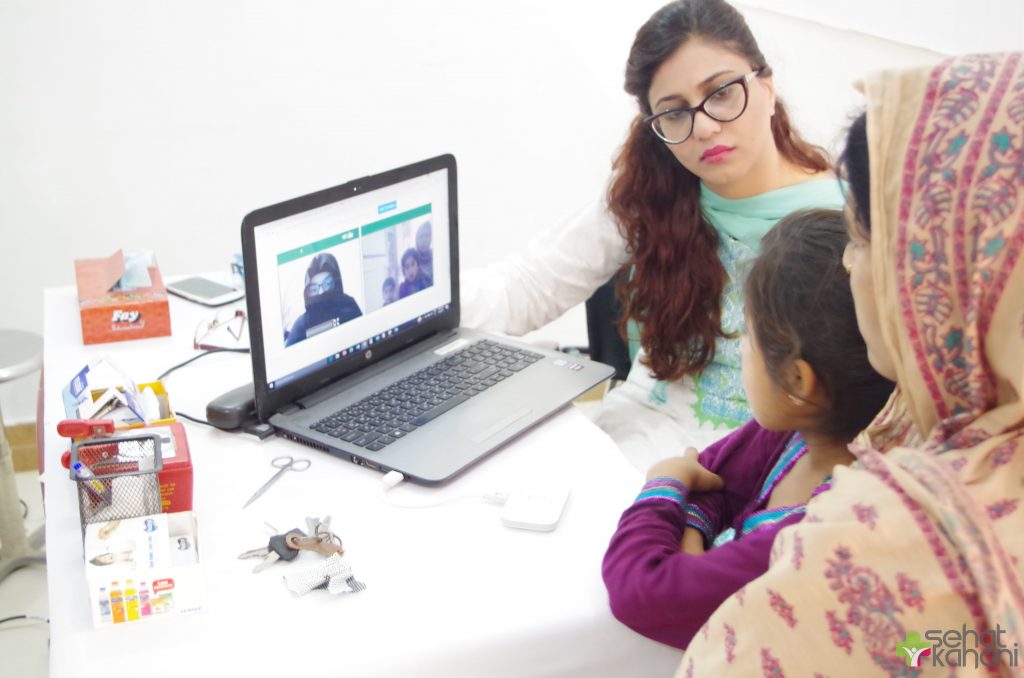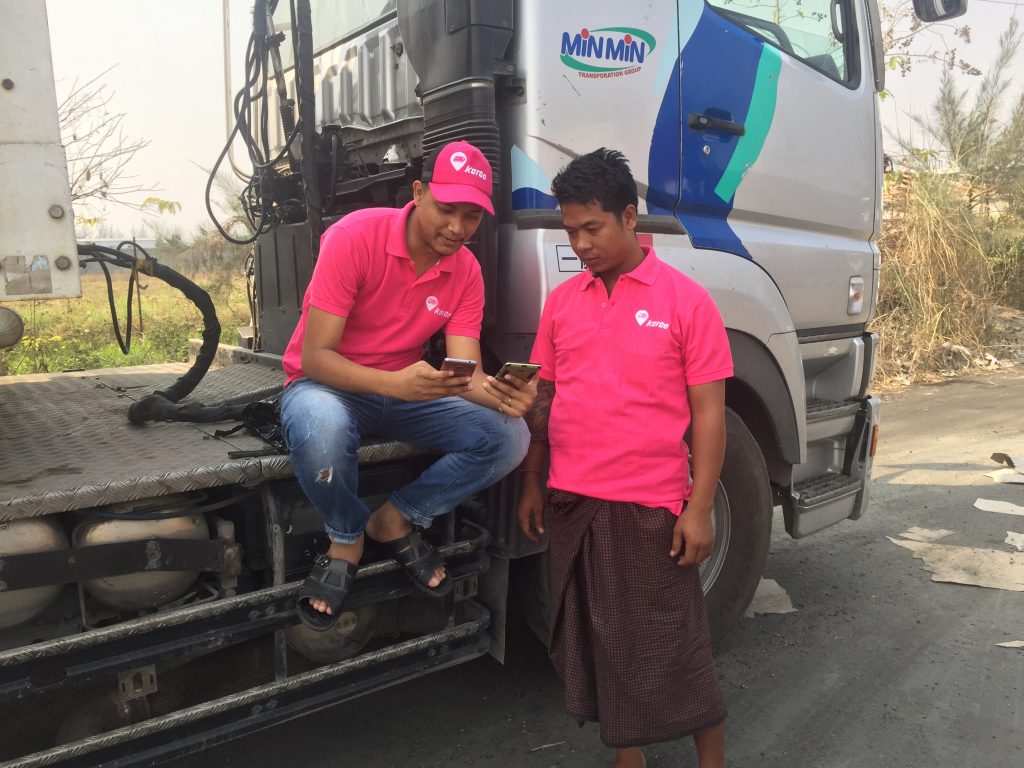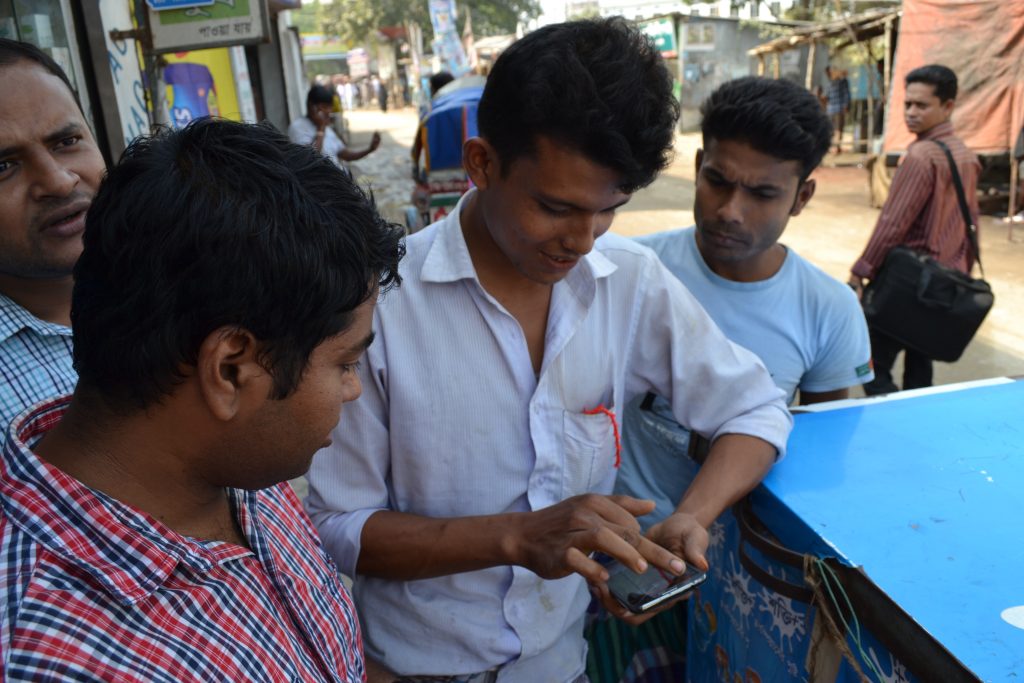Lessons learnt from Ecosystem Accelerator Innovation Fund
The GSMA Ecosystem Accelerator Innovation Fund was launched in 2016 to provide selected start-ups in Asia-Pacific and Africa with grant funding, technical assistance, and the opportunity to partner with local mobile operators to scale their products and services into sustainable businesses with positive socio-economic impact.
Spanning across three rounds, the Ecosystem Accelerator programme has built a portfolio of 34 start-ups across Asia Pacific and Africa, and facilitated 25 partnerships between start-ups and mobile operators. Collectively, these companies have gone on to raise over £180 million in additional funding, as of March 2020, representing 28.5 times the amount the programme has disbursed to these ventures. The 34 projects have had a positive socio-economic impact on over nine million citizens.
For the second round of the Ecosystem Accelerator Innovation Fund in August 2017, the Australian Government joined our founding partner, DFID, to not only provide additional start-up funding, but to help the selected start-ups harness the power of mobile technology to deliver impact in their local societies and economies.
Meet the start-ups
- eFishery – IoT-based smart fish-feeding machines for commercial aquaculture in Indonesia (partnered with Telkomsel), impacting SDGs 2 and 14;
- Field Buzz – mobile software to manage last-mile distribution and operations efficiently in Bangladesh (partnered with Grameenphone), impacting SDGs 8 and 9;
- Joonaak – delivery service providing logistics for micro and small e-commerce businesses in Cambodia (partnered with Smart Axiata), impacting SDGs 8 and 10;
- Karzo – anonline logistics platform providing delivery for businesses and individuals in Myanmar (partnered with Telenor), impacting SDGs 8 and 9;
- New Day – low-income jobs platform providing job matching, skills training and employer transparency in Myanmar, impacting SDGs 8 and 10; and
- Sehat Kahani – mobile health services provided by female doctors to marginalised populations through telehealth in Pakistan (partnered with Jazz), impacting SDGs 3 and 5.
In this blog, we share seven lessons from Round 2 of the GSMA Ecosystem Accelerator Innovation Fund in countries across Asia Pacific, including Bangladesh, Cambodia, Pakistan, Indonesia, and Myanmar.
1. Build trust with your target market
A vital step in reaching the end user is that once sufficient market research is completed, the start-up must establish trust within the community. In Field Buzz’s experience, it was challenging to sign up the first few client organisations and users. The start-up found it necessary to make use of all its resources to demonstrate the product to users, and found it useful to pilot products while taking in customer feedback on product features and pricing.
An important way to maintain trust is to ask for feedback from users and build a product worth using. Joonaak spent a great deal of time talking to users about each product feature and how they felt about the product’s design. The e-commerce start-up incorporated this feedback to build a more user-friendly and human-centred product.
Understanding the end-user’s socio-cultural context is crucial to gaining their trust. Sehat Kahani’s lesson in unanticipated cultural issues highlights the importance of in-depth research to understand the end-user’s context. The telemedicine start-up discovered active user traction was lower in one community because women did not go out as often compared to other parts of Pakistan. It took longer to build traction there and resulted in a lower turnout than expected. However, the number of people that benefitted from Sehat Kahani’s solution in this community exceeded expectation as the Pakistan-based start-up underestimated that the families of all the users would benefit from their service.
2. Get to know your users thoroughly by conducting continuous user research
User feedback sessions must be conducted to get greater insight into what is needed. eFishery, for instance, found it helped to understand what was expected from its devices and farm management dashboard in order to design and improve the service. The start-up released the beta version of the dashboard with a target of only reaching 10 SMEs, but signed up 50 SMEs in the first week of launching. They believe user interest was high as they did thorough on-site user research.
In Karzo’s experience, qualifying and developing user and market understanding required sustained monitoring and evaluation throughout the project. While their SME app was intended for business customers, feedback from several users indicated that SMEs were keen to test products as individual users before registering a company account. Although it is not primarily a customer group for the mobile app, the ‘Individual Customer’ option was created to enable this evaluation for Karzo’s service, especially as e-commerce continues to grow in Myanmar.
Finally, Field Buzz realised that its intensive sales and onboarding process provided extensive opportunities to get direct client and user feedback about how features and workflows were structured, what might be missing, and whether it was intuitive or not. This enabled the start-up to rapidly produce many iterations of the software, with well over 100 versions of the base Android app within six months.
3. Improve your product continuously and factor in technical risks early
Karzo realised it had to carefully consider the appropriate markets in which to launch its app. Rolling back an application once deployed in a particular market is a complicated process that should be avoided, so designing and re-designing their web-based installation packages was found to be essential.
A team of talented people is critical for creating a successful product, and eFishery realised that having a bigger team meant they could complete more tasks without compromising the result. Executing tasks quickly provided spare time for perfecting their work. They also recruited more product team members to launch specific features, which enabled them to achieve their product design milestone one month early.
New Day’s job matching platform attracted many willing participants to not only sign up, but fully register and create CVs with their platform, and then to browse and apply for jobs. This was largely thanks to strong product design – an uncomplicated user interface, including easy-to-use chat apps. This highlights the importance of a user-friendly platform to not only attract users but to get them to complete registration. Their focus on a natural language chat bot on the Facebook Messenger platform generated a high level of engagement among users, which enabled them to serve low-income job seekers who might lack a high level of education including ICT. New Day also found that educating job seekers on professional behaviour was appreciated by both job seekers and employees, so they incorporated this into their product. This included advising job seekers on their interview attire and emphasising the importance of punctuality.
The incorporation of technology often comes with technical risk. The Sehat Kahani app launch was delayed due to technical and financial constraints as the cost of development was much higher than initially anticipated. App development was planned for three months, but the entire platform – including testing – took almost a year. The final version of the app was released in February, 2019. The lesson from this is that conducting detailed research of app developers prior to budgeting is crucial so as to get a better cost estimate for the product. That being said, if Sehat Kahani had not spent all this time perfecting their product, they might not have been able to quickly respond to the COVID-19 pandemic.
Another technical challenge was encountered by Joonaak, when they had to move data from one server to another. The time it takes for data and server migration should not be underestimated – it often takes longer than expected, since data is structured differently from one system to another.
4. Combine tech with touch – offline grassroots community engagement matters
Karzo found that greater user engagement is key to product utilisation in Myanmar. While their product is digital, it is still vital to have that human connection. On-the-ground customer engagement is key to user technology uptake and mobile-based conceptualisation and understanding. Events and roadshows ultimately benefit consumer utilisation and the retention of mobile products. Karzo also found that consumer responsiveness to new products remained largely via word-of-mouth and physical events, while advertising and marketing through media or data-driven products was a useful first point of introduction for users. The success of existing ride-hailing providers, notably Grab in the Yangon taxi market, led to many users becoming familiar with the flow of apps. Emulating Grab’s strategies likely made Karzo’s education of users easier, as user education is often a labour-intensive process. In-app tutorials were a key future strategic objective, applying to both drivers and customers alike.
To ensure reaching its target market, eFishery did as many on-the-ground events as possible. Their strategy was largely focused on the grassroot and community level, so they did more events than planned and this proved to be effective. Building on their strategy of continuously asking users for feedback, Joonaak realised that user training should also be continuous. Training should continue in order to get users to understand the app’s processes and how to properly use addresses for deliveries.
5. Nurture your MNO partnership
A start-up with a long-term view can achieve quick wins when opportunity comes. This is demonstrated in Field Buzz’s journey – they had been working tirelessly to get an MNO partnership for a long time. Finally, they partnered with Grameenphone’s B2B marketplace and formalised the partnership with very short notice. Field Buzz became one of the first four software as a service (SaaS) providers to be featured in the marketplace.
Dealing with an MNO partner is made easier with an internal champion. While this is not always easy to secure, it certainly makes the partnership stronger. Once eFishery had established a relationship with their MNO contact and discussed their project, the process of formalising the relationship moved swiftly and an MOU was quickly signed. They were able to strengthen their partnership with the largest telecom operator in the country, Telkomsel, which provides IoT network support to eFishery. Furthermore, bringing in important stakeholders can encourage MNOs to move quickly. This is what eFishery experienced – they partnered with the Indonesian government and Japfa (a pan-Asian industrial agri-food company) for implementation of their NB-IoT project, which meant they were able to secure a partnership agreement with Telkomsel.
In liaising with their MNO, Sehat Kahani realised that their partnership with Jazz took up a great deal of time and effort from management, so it was later realised that dedicated account managers would be needed to engage MNO partners. Joonaak developed a strong partnership with Smart Axiata in Cambodia and recently became their nationwide partner, delivering HR-related material to its employees. This demonstrates the future collaboration that is possible when partnered with an MNO.
6. Empowering women is good for business
GSMA Connected Women’s research across multiple markets in Asia has revealed that women are usually less likely than men to see how a mobile phone and mobile services can be useful for them and benefit their lives through, for instance, employment opportunities. However, identifying women as users and beneficiaries proved useful for two of our start-ups.
Promisingly, nearly half of New Day job-seeking users are women. The start-up does not have a marketing strategy specific to women, but found that many of the jobs focused on Quality Assurance, Data Entry, Marketing, Administration, and Accounting have many qualified women candidates. They have been able to effectively show, match and guide these women to jobs on their platform.
Joonaak found that the majority of their merchants were women. They conducted research on their merchant user base and discovered that 95 per cent of their users were women between the ages of 21 to 35, and six out of 10 users had either a full-time or a part-time job. This was a very interesting finding as it helped them develop their services to target a particular user segment – young women already working but keen to start their own side-businesses. Their research showed that women were more successful on the platform as “they are more innovative”. For instance, women edited photos on their phone, wrote catchy captions and spent time chatting with users and answering their questions. Therefore, women should not only be viewed as beneficiaries, but as resourceful agents.
7. Build your pricing and business model on customer feedback
Product design should not be the only aspect of the business to be built on user feedback – New Day realised that after trying various pricing models throughout the project, their clients wanted a ready-made solution, rather than a pure SaaS product. They believe this is due to the maturity of the market, and the nature of their HR user base.
Joonaak found that adjusting their product pricing was effective in attracting more users. Initially their starting price of a single delivery was $1.50, but they have managed to adjust it as low as $1.00. They attracted sellers with lower prices to learn more about delivery outsourcing and expose them to their technology. This resulted in faster user uptake and generated more volume.
Listening to users about pricing proved advantageous for eFishery – based on customer feedback, they evolved their business model which now holds more value for the customer. They added several propositions, such as a marketplace for selling fish and opportunities to raise bank financing.
Finally, it can be useful torun several pricing experiments as Field Buzz did, based on the SaaS per-user per-month general concept. They developed a model where additional modules could be purchased over time. They found that piloting the product at the start lowered the barriers to entry for new client organisations, while also giving scope for “add-on sales” once the organisation was more comfortable that the software delivered real value. The start-up was very grateful to have the foundation of the GSMA funding to be able to run pricing experiments, focus on product features and client needs, rather than enforcing short-term bootstrapping profitability. They are convinced that rolling out the SaaS business model (per-user per-month pricing, low barriers to entry), and the SaaS engineering architecture (multitenant database, modular structure with specific configurations) was the best way to scale up quickly and achieve social impact on a significant scale.
The Ecosystem Accelerator programme is supported by the UK Department for International Development (DFID), the Australian Government, the GSMA and its members.



